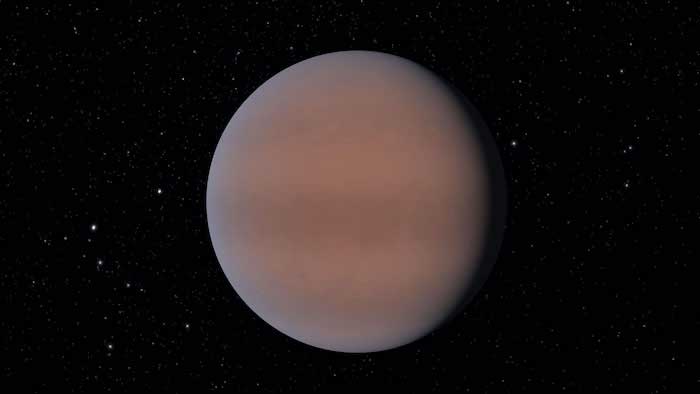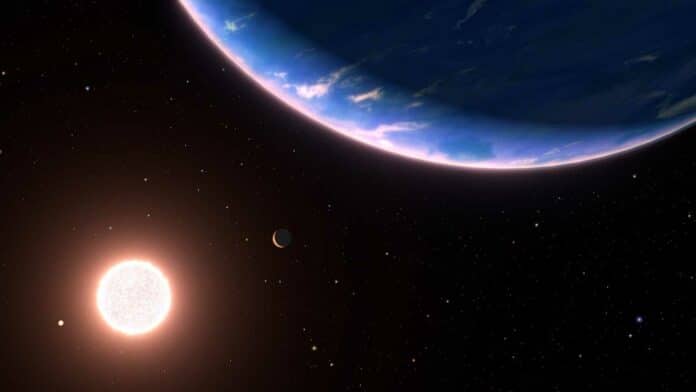In the past decade, advancements in exoplanet transmission spectroscopy, largely facilitated by observatories like the Hubble Space Telescope, have allowed scientists to study the atmospheres of numerous exoplanets. A significant finding has been the widespread presence of atmospheric aerosols, often hindering the analysis of exoplanet chemical compositions.
Researchers have tentatively identified trends suggesting that the clarity of planetary atmospheres might be linked to equilibrium temperature. However, due to the grouping of dissimilar planets in previous studies to enhance statistical power, it remains to be seen whether these planets share similar atmospheric physics and chemistry-based solely on observed transmission spectra.
A new study presents a reanalysis of a smaller, more physically similar sample of 15 exo-Neptune transmission spectra across a wide range of temperatures. Exoplanet researchers, particularly those at the ExoLab at the University of Kansas, primarily utilize data from space-borne telescopes like the Hubble Space Telescope and the Webb Space Telescope.
The recent study provides enhanced atmospheric insights into a group of 15 exoplanets similar to Neptune. While these planets may not be suitable for human habitation, gaining a better understanding of their behavior can contribute to unraveling the reasons behind the apparent absence of a small Neptune in our solar system, especially considering that such planets are commonly found in other solar systems.
Jonathan Brande, a doctoral candidate in the ExoLab at the University of Kansas, said, “Over the past several years at KU, my focus has been studying the atmospheres of exoplanets through a technique known as transmission spectroscopy. When a planet transits, meaning it moves between our line of sight and the star it orbits, light from the star passes through its atmosphere, absorbed by the various gases present.”
“By capturing a spectrum of the star — passing the light through an instrument called a spectrograph, akin to passing it through a prism — we observe a rainbow, measuring the brightness of different constituent colors. Varied areas of brightness or dimness in the spectrum reveal the gases absorbing light in the planet’s atmosphere.”

A few years ago, Brande published a paper about the exoplanet TOI-674 b, a “warm Neptune.” The study showed signs of water vapor in its atmosphere. This research was part of a more extensive program led by Brande’s adviser, Ian Crossfield, at KU, studying the atmospheres of Neptune-sized exoplanets. The goal is to understand these planets, especially the ones slightly larger than Earth and smaller than Neptune, as they are the most common in the galaxy.
This recent study compiles observations from a program studying Neptune-sized exoplanets, including additional data. The aim is to understand why some planets look cloudy while others appear clear. The focus is on exploring the physical reasons behind these distinct appearances.
Researchers focused on areas where exoplanets often develop high-altitude clouds or hazes. When these atmospheric aerosols are present, they can obstruct the light passing through the atmosphere, influencing the planet’s appearance.
Brande said, “If a planet has a cloud right above the surface with hundreds of kilometers of clear air above it, starlight can easily pass through the clear air and be absorbed only by the specific gases in that part of the atmosphere. However, if the cloud is positioned very high, clouds are generally opaque across the electromagnetic spectrum. While hazes have spectral features, for our work, where we focus on a relatively narrow range with Hubble, they also produce mostly flat spectra.”
“When these aerosols are high in the atmosphere, there’s no clear path for light to filter through.”
“With Hubble, the single gas we’re most sensitive to is water vapor. If we observe water vapor in a planet’s atmosphere, that’s a good indication that there are no clouds high enough to block its absorption. Conversely, if water vapor is not observed and only a flat spectrum is seen, despite knowing that the planet should have an extended atmosphere, it suggests the likely presence of clouds or hazes at higher altitudes.”
Brande and his collaborators took a unique approach in their analysis. Instead of fitting a single model spectrum to observations, they focused on determining the physical parameters of small-Neptune atmospheres.
Brande explained, “Typically, researchers would take an atmospheric model with pre-computed water content, scale and shift it to match observed planets in their sample.”
However, this method only indicates whether the spectrum is clear or cloudy and provides no details about the amount of water vapor or the location of clouds in the atmosphere.
Instead, Brande used a technique called “atmospheric retrieval,” aiming to extract more detailed information about the atmospheres of these small exoplanets.
Brande said, “This involved modeling the atmosphere across various planet parameters such as water vapor quantity and cloud location, iterating through hundreds and thousands of simulations to find the best-fit configuration.”
“Our retrievals gave us a best-fit model spectrum for each planet, from which we calculated how cloudy or clear the planet appeared. Then, we compared those measured clarities to a separate suite of models by Caroline Morley, which let us see that our results are in line with expectations for similar planets. In examining cloud and haze behavior, our models indicated that clouds fit better than hazes.”
“The sedimentation efficiency parameter, reflecting cloud compactness, suggested observed planets had relatively low sedimentation efficiencies, resulting in fluffy clouds. These clouds made up of particles like water droplets, remained lofted in the atmosphere due to their low settling tendency.”
In an international observation program led by Crossfield, Brande contributed to the recent discovery of water vapor on GJ 9827d—a hot planet resembling Venus, located 97 light-years away in the constellation Pisces. Utilizing the Hubble Space Telescope, these observations suggest that GJ 9827d might be just one instance of water-rich planets within the Milky Way. The findings were announced by a team led by Pierre-Alexis Roy from the Trottier Institute for Research on Exoplanets at the Université de Montréal.
Brande said, “We were searching for water vapor on the atmospheres of sub-Neptune-type planets. Pierre-Alexis’ paper is the latest from that main effort because it took approximately 10 or 11 orbits or transits of the planet to make the water-vapor detection. Pierre-Alexis’ spectrum made it into our paper as one of our trend-data points, and we included all the planets from their proposal, and others studied in the literature, making our results stronger. We were in close communication with them during the process of both papers to ensure we used the proper updated results and accurately reflected their findings.”
Journal Reference:
- Jonathan Brande et al. Clouds and Clarity: Revisiting Atmospheric Feature Trends in Neptune-size Exoplanets. The Astrophysical Journal Letters. DOI 10.3847/2041-8213/ad1b5c
